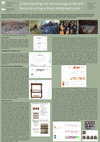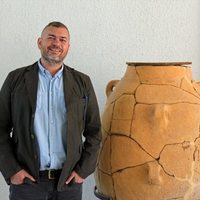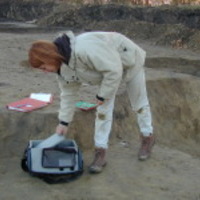Posters by tena karavidovic

The paper deals with a reconstruction of a warp-weighted loom based on a rare find of 36 in situ ... more The paper deals with a reconstruction of a warp-weighted loom based on a rare find of 36 in situ loom weights in an object interpreted as a weaving hut at an archeological site Virje-Sušine in Northern Croatia dated in late iron age (LtC 2/2 3rd – 2/2 2nd century BC). The case study includes theoretical framework for warping based on defining functional elements of different types of loom-weights (thread density, what yarn to use) and study of wear marks on weights which defined the way of usage. Series of experiments were carryed out to define possible distribution of weights in the same loom setup, characteristics of woven cloth and wooden loom construction. Linear distribution of different types of loom-weights and weights with incised signs within optimal loom setup showed some regularities which can be connected with tehnological requirement of producing cloth on a warp-weighted loom but also with design/pattern making.

Razlike u oblikovanju i težini utega, položaj unutar istražene cjeline te tragovi uporabe na poje... more Razlike u oblikovanju i težini utega, položaj unutar istražene cjeline te tragovi uporabe na pojedinim utezima, potakli su autorice na eksperimentalni pristup sagledavanja izgleda pronađenog tkalačkog stana. Na temelju provedenih eksperimenata stvoreni su zaključci o izgledu konstrukcije tkalačkog stana, mogućem načinu uporabe utega i postavljanja tkalačkog stana, funkciji oznaka na utezima te tipu korištene niti i izgledu tkanja. Za potrebe eksperimenata izrađene su replike virovskih utega (sl. 6) Tkanina je izvedena tehnikom običnog tkanja (eng. tabby), koja se smatra osnovnom, najjednostavnijom tehnikom tkanja. Korištena je tijekom neolitika, brončanog i željeznog doba, a prema poznatim nalazima tekstila s područja istočne i zapadne Europe, čini se najučestalijom tehnikom u razdoblju mlađeg željeznog doba (Bender Jørgensen 2005: 134, fig 1, 2; Belanová Štolcová, Grömer 2010: 16; Bender Jørgensen, Grömer 2012: 100, sl. 7). Objekt u kojemu se nalazi tkalački stan moguće je interpretirati kao radni prostor namijenjen isključivo za tkanje (eng. weaving hut). Drvena konstrukcija tkalačkog stana unutar objekta vjerojatno je stajala prislonjena ili konstrukcijski vezana uz sjeverni rub objekta. Prema broju utega pronađenih pri dnu objekta te dužini traga drvene grede pretpostavljeno je da je širina konstrukcije mogla okvirno iznositi oko 260 cm. Maksimalna širina tkanine koja se mogla proizvesti na tkalačkom stanu, kada bi svih 36 utega stajalo postavljeno u dva paralelna reda iznosila bi 170 – 180 cm. Širina tkanine koja se mogla proizvesti s 28 linijski raspoređenih utega pronađenih uz sjeverni rub objekta iznosila bi 140 – 150 cm. Zajedno postavljeni, utezi su idealno namijenjeni izradi tkanine s debljim nitima osnove (4 – 6 niti na cm). Konstrukcija je vjerojatno bila prilično masivna jer je prilikom tkanja pomicanjem horizontalne prečke potrebno pomaknuti oko 15 kg odnosno 20 kg utega, ovisno o širini tkanine. Na temelju prostornog rasporeda utega utvrđenog istraživanjem, predložena je rekonstrukcija položaja utega za koje je pretpostavljeno da su činili jedinstven postav tkalačkog stana. Radi se o 28 linijski raspoređenih utega pronađenih uz sjeverni rub objekta. Ostali utezi isključeni su iz pokušaja rekonstrukcije obzirom da njihov položaj ne odgovara konstrukcijskim normama vertikalnih tkalačkih stanova. Predloženi raspored utega ukazao je na postojanje pravilnosti i simetrije u položaju utega s oznakama, oblikovno različitih utega (tip I, II, III) te utega različite težine i širine (sl. 8, 9). Pretpostavljeno je da su utezi s oznakama kao i pojedini oblikovno različiti utezi označavali dijelove tkanine koji su mogli biti izvedeni drugom bojom, uzorkom, tehnikom itd. Raspored utega različitih razreda težine ukazao je na mogući način postizanja pravilne razine i distribucije opterećenja u odnosu na ukupnu širinu tkanine koja se proizvodi, odnosno na konstrukciju vertikalnog tkalačkog stana (sl. 9). Specifičan način postizanja uravnotežene raspodjele težine uzrokovan je tehnološkim aspektom proizvodnje tkanine određene širine, no vjerojatno i predodređenim položajem pojedinih utega (utezi s oznakama, oblikovno različiti utezi). Oblik utega upućivao je na njegovu težinu bitnu pri odabiru položaja pojedinog utega kao i pričvršćivanja prikladnog broja niti. Niti osnove vjerojatno su bile pričvršćivane na utege posredno, preko svojevrsne omče na što upućuju tragovi uočeni na pojedinim utezima kao i eksperimentalno testiranje ovakvog načina pričvršćivanja. Jedan sasvim specifičan uteg na svim bočnim kao i gornjoj plohi nosi različite oznake (sl. 5). U kontekstu iznesenih pretpostavki, ove oznake mogle bi biti u vezi s načinom postavljanja tkalačkog stana s obzirom na zahtjeve izrade specifičnog tipa tkanine odnosno ukazivati na prostorni raspored utega i/ili karakteristike tkanine koja se proizvodi. sl. 3. Objekt SJ 424/425 s keramičkim utezima in situ sl. 2. Objekt SJ 424/425 (snimio: Ivan Valent; crtež: dr. sc. Kristina Jelinčić Vučković) sl. 4. keramički utezi in situ, detalj
Papers by tena karavidovic
Archaeopress Publishing Ltd eBooks, Oct 7, 2021

Systematic, well-designed experimental research and standardized documentation is a starting poin... more Systematic, well-designed experimental research and standardized documentation is a starting point for explaining the outcome of experiments and comparative analyses, whether within single experimental research or a wider frame of comparison with other research. This contribution presents a sequence of research procedures that served as a basis for the design and implementation of experiments related to bloomery iron production procedures. A proposal for the method of documentation is made with the aim of combining all general functional parameters relevant to the procedures of ore preparation and direct process of reduction in the reconstruction of a smelting furnace, based on personal experiences and the current state of experimental research related to iron production. The objective is to give a structured basic template of main parameters that should be recorded and reported when performing experiments related to the mentioned procedures. The hope is to bring forward a layout that should be upgraded and further developed based on specific research questions one could have.
Prilozi Instituta za arheologiju u Zagrebu, Dec 21, 2016
Annales Instituti Archaeologici, Nov 18, 2015
Annales Instituti Archaeologici, Nov 18, 2015
Sotin i Opatovac, probna arheološka istraživanja višeslojnih nalazišta 2014. godine Sotin and Opa... more Sotin i Opatovac, probna arheološka istraživanja višeslojnih nalazišta 2014. godine Sotin and Opatovac, trial research of multilayered sites in 2014
Archaeopress Publishing Ltd eBooks, Oct 7, 2021
Geologia Croatica, Feb 28, 2022
Archaeological excavations in the Podravina region led to discovery of sites with traces of bloom... more Archaeological excavations in the Podravina region led to discovery of sites with traces of bloomery iron production during Late Antiquity and the Early Middle Ages. Mineralogical analysis of the slags recognized fayalite as the main mineral phase, while geochemical analysis confirmed high Fe contents, typical for bloomery iron smelting. Based on the previously established occurrences of bog iron ores in the study area, provenance studies were carried out using trace and rare earth elements to create a geochemical signature. Similar shapes and patterns of bog iron ores and iron slag signatures imply a genetic connection between the ore and the slag, as well as variation related to the temporal and spatial context of both slags and ores.
Archaeopress Publishing Ltd eBooks, Oct 7, 2021
This paper presents basic objectives and methods used to design the spatial database within the p... more This paper presents basic objectives and methods used to design the spatial database within the project ‘Iron production along the Drava River in the Roman period and the Middle Ages: Creation and transfer of knowledge, technologies, and goods’ (TransFER), funded by the Croatian Science Foundation (IP-06-2016-5047). The database has been conceived and implemented to facilitate spatial analysis based on the objectives of the research into iron production along the Drava River in Late Antiquity and the Early Middle Ages. The selected data has been made accessible to the external user via the project’s webpage in the form of a Web-GIS browser.
Rezultati zaštitnih istraživanja kasnoavarodobnoga groblja Šarengrad-Klopare 2019. godine The res... more Rezultati zaštitnih istraživanja kasnoavarodobnoga groblja Šarengrad-Klopare 2019. godine The results of the rescue excavations of the Late Avar Age cemetery of Šarengrad-Klopare in 2019

CATENA, 2021
Abstract Throughout the Podravina region, NE Croatia, over one hundred locations with signs of ir... more Abstract Throughout the Podravina region, NE Croatia, over one hundred locations with signs of iron production, dating to the late Antique period and the Middle Ages, have been discovered in the last 30 years. Recently, signs of various bog iron ore types and formations were discovered throughout the area. This study investigates the mineralogical and geochemical characteristics of local bog iron and roasted iron ores. Furthermore, statistical clustering of different geochemical components in the ores is presented, while the abundance and distribution of macro-, micro- and rare earth elements (REE) and how they correlate within the bog iron ores and roasted iron ores is considered. A total of 15 samples acquired from geological investigations and 13 samples found during archaeological excavations were analysed using geochemical and mineralogical methods. In bog iron ores, X-ray diffraction (XRD) confirmed goethite and quartz as the primary mineral phases, while roasted iron ores contained several Fe minerals and had variable quartz and clay mineral contents. Chemical analyses confirmed high Fe contents in both bog iron ores (up to 70.89 mass. %) and roasted iron ores (up to 84.97 mass. %), with a distinct differentiation of Fe and Si between the different bog iron ore types. Scanning electron microscopy with attached EDS detector (SEM-EDS) showed features of laminar Fe and Mn mineralization, confirming the theory that bog iron ore forms as seasonal precipitation from groundwater. Using the hierarchical clustering analysis, a geochemical correlation of the iron component in bog iron ores and roasted iron ores was compared to other major oxides, micro- and REEs. It was established that the iron component has very little influence on REE and microelements behaviour. Therefore, microelements and REEs were used as a tracer for establishing a geographical connection between the bog iron ores and roasted iron ores in the Podravina region.
Interdisciplinary Research into Iron Metallurgy along the Drava River in Croatia, 2021
Interdisciplinary Research into Iron Metallurgy along the Drava River in Croatia, 2021
Years of research in the region of Hrvatska Podravina, a lowland area of the lower Drava River ba... more Years of research in the region of Hrvatska Podravina, a lowland area of the lower Drava River basin, resulted in the discovery of more than 150 sites with traces of iron metallurgy visible on the surface. Systematic archaeological excavations on four sites have indicated that iron was being actively produced in this area using local resources during Late Antiquity and the early Middle Ages, from the 4th/5th century to the 8th/9th. Structures and formations interpreted through the archaeological record indicate that different activities or phases of the chain of operations were carried out within organized units, workshops for the production and/or processing of bloomery iron.
Years of research in the region of Hrvatska Podravina, a lowland area of the lower Drava River ba... more Years of research in the region of Hrvatska Podravina, a lowland area of the lower Drava River basin, resulted in the discovery of more than 150 sites with traces of iron metallurgy visible on the surface. Systematic archaeological excavations on four sites have indicated that iron was being actively produced in this area using local resources during Late Antiquity and the early Middle Ages, from the 4th/5th century to the 8th/9th. Structures and formations interpreted through the archaeological record indicate that different activities or phases of the chain of operations were carried out within organized units, workshops for the production and/or processing of bloomery iron.

Prilozi Instituta za arheologiju u Zagrebu
Temeljna sirovina za proizvodnju željeza tijekom kasne antike i ranoga srednjeg vijeka na prostor... more Temeljna sirovina za proizvodnju željeza tijekom kasne antike i ranoga srednjeg vijeka na prostoru Podravine bila je močvarna željezna ruda. Analiza rudnih ležišta i svojstava ruda može doprinjeti razumijevanju prirodnih mehanizama koji uvjetuju način eksploatacije i uporabu ruda u prošlosti. Međutim, ubikacija ležišta je izazovna zbog mogućnosti degradacije, potpunoga iskorištavanja te inhibicije obnove ili razvoja ležišta, prvenstveno uzrokovanih ljudskom aktivnošću i utjecajem na okoliš. U suvremenome krajoliku Podravine najviši potencijal za razvoj ležišta i jedino, djelomično razoreno ležište, ustanovljeno je na položaju Kalinovac – Hrastova greda 1 – 3. Na osnovi njegove analize izveden je model mehanizma formiranja, fizionomije i položaja ležišta u Podravini te je povedena rasprava o metodama eksploatacije kao i potencijanim prostorima pojave ležišta u odnosu na položaje arheoloških lokaliteta s tragovima proizvodnje željeza. U svrhu analize tehnološke iskoristivosti ruda sli...

RILEM Bookseries, 2019
During the Roman period, the area of Varaždinske Toplice (northwestern Croatia) was the site of t... more During the Roman period, the area of Varaždinske Toplice (northwestern Croatia) was the site of the Aquae Iasae settlement, famous for the healing properties of its thermal sulphur water. Around the thermal spring, the Romans built the sanctuary and to its south, a bath complex. The excavations conducted from 2011 to 2015 have shown that in the 2nd century AD a rectangular structure of 8 × 13.5 meters in size was built around the natural hot spring i.e. a reservoir used for catchment, in the same manner as in the Roman settlement of Aquae Sulis (Bath). In order to make the ground suitable for construction oak piles were driven in below the walls before the foundations were laid down, while the terrain was stabilized in and around the reservoir. The walls of the reservoir – “sacred spring”, were built of large stone slabs, employing the opus quadratum technique. The walls were repaired in the 4th century AD using older inscriptions, reliefs, and even sculptures as regular construction material (more than 50 stone monuments were found). The spring itself contained more than 17,000 Roman coins left as votive offerings. Most of the finds were in a very bad condition because of the detrimental effects of sulphur water, which calls for rather complex conservation approach.

Secrets of iron - from raw material to an iron object, Zbornik Instituta za arheologiju, Vol. XX / Serta Instituti Archaeologici XX, 2022
The Pokuplje area (central Croatia) and its mountainous fringe have great potential for the produ... more The Pokuplje area (central Croatia) and its mountainous fringe have great potential for the production of iron in archaeological periods, including the Iron Age. The potential results both from the availability of natural resources and from a close cultural and geographical connection with the neighbouring iron-producing regions on the territory of present-day NW Bosnia and SW and central Slovenia. The region is understudied from an archaeological perspective, so finds related to iron production are scarce. This paper discusses rare finds (slag, technical ceramics, iron bloom) related to iron production and processes carried out on two sites, Gornje Pokupje (Late Iron Age)
and Sisak–Pogorelac (Late Hallstatt/Early La Tene). The potential for iron production during the Iron Age is discussed on the basis of archaeological traces of iron production processes and ore availability (type of ore, spatial distance, possible mining methods) and suitability for direct reduction. The methods used consist of macroscopic analysis of archaeological finds and the spatial analysis of the relationships between geologically known deposits, historically recorded mining areas and potential areas with occurrences of ore, suspected based on geochemical data on topsoil saturation with iron of geogenic origin.
Key words: bloomery iron production, post-reduction slag, technical ceramics, Iron Age, ore deposits, spatial analysis











Uploads
Posters by tena karavidovic
Papers by tena karavidovic
and Sisak–Pogorelac (Late Hallstatt/Early La Tene). The potential for iron production during the Iron Age is discussed on the basis of archaeological traces of iron production processes and ore availability (type of ore, spatial distance, possible mining methods) and suitability for direct reduction. The methods used consist of macroscopic analysis of archaeological finds and the spatial analysis of the relationships between geologically known deposits, historically recorded mining areas and potential areas with occurrences of ore, suspected based on geochemical data on topsoil saturation with iron of geogenic origin.
Key words: bloomery iron production, post-reduction slag, technical ceramics, Iron Age, ore deposits, spatial analysis
and Sisak–Pogorelac (Late Hallstatt/Early La Tene). The potential for iron production during the Iron Age is discussed on the basis of archaeological traces of iron production processes and ore availability (type of ore, spatial distance, possible mining methods) and suitability for direct reduction. The methods used consist of macroscopic analysis of archaeological finds and the spatial analysis of the relationships between geologically known deposits, historically recorded mining areas and potential areas with occurrences of ore, suspected based on geochemical data on topsoil saturation with iron of geogenic origin.
Key words: bloomery iron production, post-reduction slag, technical ceramics, Iron Age, ore deposits, spatial analysis
We are pleased to invite you to the7th International Scientific Conference on Mediaeval Archaeology of the Institute of Archaeology " Secrets of iron - from raw material to an iron object“
The conference will be held in Zagreb, Croatia, 3 - 6 June 2020.
Theme of the Conference includes all archaeological periods. Since the character of this subject transcends the traditional boundaries of the archaeological discipline, so we are looking forward to a multidisciplinary encounter of different ideas, approaches, methods, results and interpretations.
- the official languages of the conference are Croatian and English,
- if you plan to deliver your presentation in Croatian, we kindly ask you to submit the title and summary of the presentation in both Croatian and English,
- presentations are limited to 20 minutes.
Please see the attached file for more details.
//
Poštovane kolegice i kolege,
zadovoljstvo nam je pozvati Vas na 7. međunarodni znanstveni skup srednjovjekovne arheologije Instituta za arheologiju „Tajne željeza - od sirovine do željeznog predmeta / Secrets of iron - from raw material to an iron object“
Skup će se održati od 3. do 6. lipnja 2020. u Zagrebu.
Tema skupa obuhvaća sva arheološka razdoblja i nadilazi okvir arheološke discipline te stoga priželjkujemo multidisciplinarni susret različitih ideja, pristupa, metoda, rezultata i interpretacija.
- službeni jezici skupa su hrvatski i engleski,
- ako planirate izlagati na hrvatskom jeziku, molimo da naslov i sažetak izlaganja pošaljete na hrvatskom i engleskom jeziku,
- predviđeno trajanje izlaganja je 20 minuta.
Za više detalja pogledajte priložene dokumente.
Project presents the results of the scientific project ‘Production of Iron Along the Drava River During Antiquity and Middle Ages: Creation and Transfer of Knowledge, Technology and Commodities - TransFER project (IP – 2016 - 06 - 5047)’ funded by the Croatian Science Foundation. The research presented explores the evidence for and nature of iron production in the lowland area of the central Drava River basin in Croatia during late Antiquity and early Middle Ages, from the turn of the 4th to the early 9th centuries. The wide-ranging methodology of the project features non-destructive archaeological site identification (surface survey and geophysics), archaeological excavation of sites with attested bloomery iron production and processing along with their associated dwelling and settlement structures, as well as experimental archaeology. The record of bloomery iron production and processing is explored via an interdisciplinary approach which examines the technology used as well as the natural resources (bog iron ores, wood and plant remains) exploited in the production process. The results of the research testify to the importance and longevity of iron production in the area of the Drava river valley.
<https://www.archaeopress.com/ArchaeopressShop/Public/displayProductDetail.asp?id=%7bAEBFE202-F7F5-47D6-811C-BCC72C8C07D6%7d>